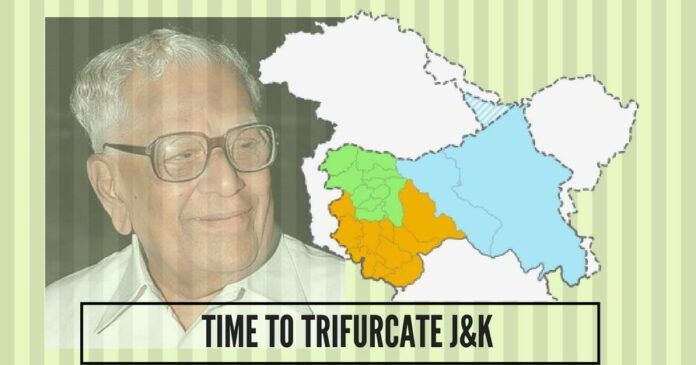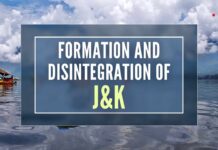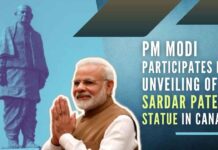
“Give statehood to Jammu, grant Union Territory status to Ladakh and deal with Kashmir separately” was Venkataraman’s suggestion to Indira Gandhi.
Mehbooba Mufti-led PDP-BJP government is out of office. It is a good riddance. It was an unholy alliance by any yardstick. The Governor’s rule has been in place in Jammu & Kashmir since June 20 following the withdrawal of support to separatist and Pakistan-friendly Mehbooba Mufti by the BJP high command at the behest of Prime Minister Narendra Modi. The BJP is in full command of the Centre. It is also in full command in the restive Jammu & Kashmir. The Governor’s rule is the Central rule. Jammu & Kashmir Governor is the most powerful Governor in the country. During the Governor’s rule, which could last for a maximum period of 6 months under Section 92 of the Jammu & Kashmir Constitution, the Governor exercises absolute executive, legislative and constitutional powers. To be more precise, the Governor during his rule is not only the constitutional head of the state but also a legislature and an executive head. He could amend the constitution any number of times. He can also make any recommendation to the Union Government. So much so, he can recommend the abolition of Article 35-A and Article 370 and recommend trifurcation of the state. This is the constitutional position.
The Congress could capture three seats in Ladakh because it sought and got the mandate on the Union Territory status plank.
Now that the BJP has withdrawn its support to the Mehbooba Mufti-led coalition government and the state has been under the Governor’s Rule, it is the most appropriate time for the BJP-led NDA Government at the Centre to look back, appreciate the 2014 mandate in Jammu & Kashmir and implement it in its entirety to end inter-regional tensions and limit the area of religious strife to the 40X80 square kilometer Kashmir Valley.
The 2014 mandate was clearly for the reorganization of the state and ending the 66-year-old inter-regional bitterness and animosity between Jammu province and Kashmir and between Kashmir and Ladakh. The State consists of three disparate regions of Jammu, Kashmir, and Ladakh. The State of Jammu & Kashmir came into being by a quirk of history in March 1846 under the Treaty of Amritsar. The Treaty was signed between Raja of Jammu, Gulab Singh, and the British Indian Government. In fact, Raja of Jammu, Gulab Singh, purchased Kashmir from the British Indian Government for Rs 75 lakh.
The 2014 mandate was really unique. The people exhibited their preferences in clear and unambiguous terms. In Jammu province, the BJP sprung a big surprise by winning 25 of the 37 assembly seats. The people of Jammu voted for the BJP overwhelmingly because it had given them to understand that a vote for it would be a vote for their socio-economic and political empowerment and vote for ending the 66-year-old Kashmiri Muslim hegemony. The BJP had also given the people of Jammu to understand that a vote for it would be a vote for “Hindu Chief Minister from Jammu”.
Obviously, the BJP’s poll planks inspired and motivated the people of Jammu province. The people rejected outright the Kashmir-based and Valley-centric pro-greater autonomy (read semi-independence) National Conference, the Congress and the pro-self-rule (read quasi-independence and Indo-Pak joint control over J&K) People’s Democratic Party. The National Conference could win only 3 seats (the lowest ever tally in decades), the Congress 5 (also the lowest-ever tally after 1965) and the PDP also 3 seats. One seat went to an independent candidate, a BJP rebel, Pawan Gupta. He won the prestigious Udhampur seat with a huge margin. Prime Minister Narendra Modi had addressed an election rally in Udhampur. No one had ever imagined that the BJP would suffer a defeat in Udhampur, but it did happen. Pawan Gupta won the seat hands down.
In Ladakh, the people, especially Buddhists, rejected both the BJP and the National Conference. They voted for the Congress. The Congress won 3 of the 4 seats – Leh, Nubra, and Zanskar. The Kargil seat was won by an independent candidate. The Congress could turn tables on the BJP despite the fact that it had won the lone Ladakh Lok Sabha seat in May 2014. The Congress could capture three seats because it sought and got the mandate on the Union Territory status plank. As for the People’s Democratic Party, it didn’t field any candidate in Ladakh either in the Lok Sabha polls or in the Assembly elections.
The State of Jammu & Kashmir had outlived its utility and that it is time to reorganize the state so that the people of each region became master in their own house.
In Kashmir, the people voted differently. They did give 25 seats to the People’s Democratic Party, but it could not be termed as a big and clear mandate. For, Kashmir returns 46 members to the 87-member House. The People’s Democratic Party won a little over than 50 per cent seats. It was the National Conference, which suffered a humiliating defeat. It could win only 12 seats, the poorest-ever performance in decades. The Congress won 4 seats. It also sprung a big surprise when it captured the Sopore seat, separatist Syed Ali Shah Geelani’s stronghold. The Kashmir-based People’s Conference, BJP’s ally, won two seats. 2 of the remaining 3 seats went to independent candidates and one seat to the CPI-M candidate, Mohd Younus Tarigami.
Even a superficial look at the 2014 mandate would be enough to conclude that the people of Jammu, Kashmir and Ladakh voted differently, thus clearly suggesting that the State of Jammu & Kashmir had outlived its utility and that it was time to reorganize the state so that the people of each region became master in their own house.
It was a different story that the BJP and the People’s Democratic Party subverted the mandate and formed a coalition government on March 1, 2015, much to the chagrin of their respective constituencies in particular and the nation as a whole. That the unnatural coalition would collapse became clear on day one and it did collapse 38 months later.
Prime Minister Narendra Modi would do well to appreciate the 2014 mandate and take steps that end the 70-year-old inter-regional tensions. The best thing to do would be to reorganize the state. The sooner it is done, the better. Such a reorganization of the state would help New Delhi deal with the restive Kashmir more effectively. It would not be out of place to mention here that former Union President, Late R Venkataraman, had also told Prime Minister Indira Gandhi that the only viable solution to the problems in Jammu & Kashmir was trifurcation of the state. “Give statehood to Jammu, grant Union Territory status to Ladakh and deal with Kashmir separately” was his suggestion to Indira Gandhi (My Presidential Years).
Note:
1. The views expressed here are those of the author and do not necessarily represent or reflect the views of PGurus.
- ‘Kashmir My core constituency’: Revisiting July 12, 2003 to understand politics, Omar Abdullah-style - March 15, 2024
- Total deviation from traditional approach: Seven takeaways from PM Modi’s March 7 Srinagar visit - March 9, 2024
- Status of political parties: Why is further J&K reorganization imperative? - March 1, 2024











If the new governor is GD Bakshi as believed, he would certainly be willing to give a keen ear to this suggestion.